The InKAS office will be closed Friday, August 23th for supporting BNS meeting. We will be open for regular office hours on Monday
Office will be closed - August 23th
Event date: 2013-08-22
Written by on date 2013-08-22 in Notices .
Hagwon (Korean: 학원) (also hagweon or hakwon) is the Korean-language word for a for-profit private institute, academy or cram school prevalent in South Korea. Although most widely known for their role as "cram schools", where children can study to improve scores, hagwons actually perform several educational functions: they provide supplementary education that many children need just to keep up with the regular school curriculum, remedial education for the children who fall behind in their work, training in areas not covered in schools, and preparation for students striving to improve test scores and preparing for the high school and university entrance examinations (the university entrance exam is also called suneung). Many other children, particularly younger children, attend nonacademic hagwon for piano lessons, art instruction, swimming, and taekwondo. Most of the young children have been to a hagwon for piano or art lessons at least once. Hagwon also play a social role, and many children, especially the younger ones, say they like going to hagwon because they are able to make new friends; many children ask to be sent because their friends attend. There are many hagwons for adults too, such as flower arrangement and driving-license hagwons.The term is also sometimes used to describe similar institutions operated by Korean Americans in the United States.

Children of all ages often attend hagwons, even those in the pre-school age bracket. It is not uncommon for students to be enrolled in several hagwon of different subject areas at once in addition to their normal school attendance. Hagwons often specialize in subjects like mathematics, foreign languages, science, arts, or music. Many hagwons also have adults as students, particularly those dedicated to teaching the English language.
While some see hagwons as filling a need not being adequately met by the public school system, others see them as creating an unequal footing between the poor and rich in Korea.
In 2008 it was reported that there were over 70,000 hagwons in South Korea with 47 percent of them focused on high school enrollment.
Impact on real estate
A higher than average concentration of hagwons in the Gangnam-gu area, specifically Daechi-dong, has been cited as the primary reason for an increase in real estate costs in the area. In the 1970s the Seoul government made some top schools relocate to the area; however, the schools there have become associated with entry into elite high schools and then elite universities. Many residents feel their children need to be associated with these schools in order to reach the upper levels of business and success. As more parents try to move to the area to allow their children to attend these schools,the prices of real estate in the area have risen to 300 percent of similar areas in Seoul. In 2003 the government had planned to develop a hagwon center in Pangyo to relieve some of the pressure on Gangnam, yet after heavy criticism for only shifting the problem around and not solving it, the government canceled the plan only a couple weeks later.
Korean shamanism, today known as Muism (Mugyo, "religion of the Mu") or sometimes Sinism (Shingyo, "religion of the gods", with shin being the Korean character derivative of the Hanja),[3] encompasses a variety of indigenous religious beliefs and practices of the Korean people and the Korean sphere. In contemporary South Korea, the most used term is Muism and a shaman is known as a mudang (무당, 巫堂) or Tangol (당골). The role of the mudang, usually a woman, is to act as intermediary between a spirit entity, spirits or gods and human beings.
Women are enlisted by those who want the help of the spirit world. Shamans hold gut, or services, in order to gain good fortune for clients, cure illnesses by exorcising negative or 'bad' spirits that cling to people, or propitiate local or village gods. Such services are also held to guide the spirit of a deceased person to higher realms.
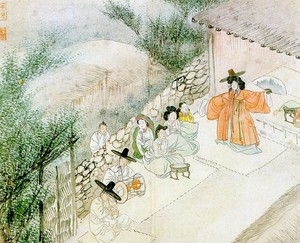
The government has discouraged belief in shamanism as superstition and for many years minimized its persistence in Korean life. Yet in a climate of growing nationalism and cultural self-confidence, the dances, songs, and incantations that compose the gut have come to be recognized as an important aspect of Korean culture.
Beginning in the 1970s, rituals that formerly had been kept out of foreign view began to resurface, and occasionally even the manager of a Western-style hotel or other executive could even be seen attending a shamanic exorcism in the course of opening a new branch in Seoul. Some of these aspects of gut have been designated valuable cultural properties that need to be preserved and passed on to future generations.
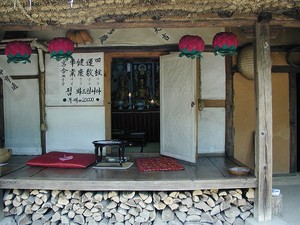
The future of shamanism itself was uncertain in the late 1980s. However, observers believed that many of shamanism's applications would probably be performed by the psychiatric profession as the government expands mental health treatment facilities in the future.
Mudang
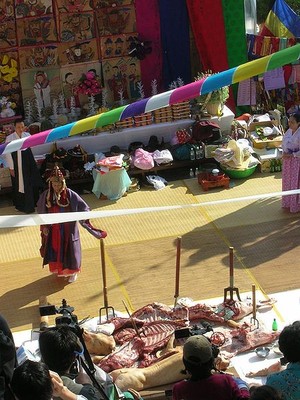
Mudang can be categorized into two basic archetypes: sessǔmu, who inherit the right to perform the shamanic rituals and kangshinmu, who are initiated into their mudang status through a ceremony. Sessŭmu historically lived in the southern part of the Korean peninsula, while kangshimu were found throughout the peninsula and contiguous areas inhabited by Koreans, but were mostly concentrated in the north (modern day North Korea) and the contiguous areas of China and the central part of the peninsula around the Han River.
Shinbyeong (spirit sickness)
The central feature of a shaman's initiation is her affliction with an illness known as a shinbyeong. This is also called the "spirit sickness" or "self-loss" and characterized by a loss of appetite, insomnia, visual and auditory hallucinations. A ritual called a naerim-gut cures this illness, which also serves to induct the new shaman.
Rituals or gut (굿)
The gut is a shamanic ritual during which the shaman offers a sacrifice to the spirits. Through singing and dancing the shaman begs the spirits to intervene in the fortunes of the humans in question. The shaman wears a very colourful costume and normally speaks in trance. During a gut a shaman changes his or her costume several times.

There are three elements of a gut. Firstly, there are the spirits as the object of folk beliefs. Secondly, there are the believers who pray to those spirits. Finally, there is the shaman mediating between the two.
The actual form of gut varies between regions. The unfolding and style of the shamanic rite depends largely on the objective of the ceremony. The individual character and abilities of the shaman bring a unique character to the respective ritual to be performed.
An ondol, also called gudeul, in Korean traditional architecture, is underfloor heating which uses direct heat transfer from wood smoke to the underside of a thick masonry floor. In modern usage it refers to any type of underfloor heating, or a hotel or sleeping room in Korean (as opposed to Western) style.
The main components of the traditional ondol are a firebox or stove (agungi; 아궁이) accessible from an adjoining (typically kitchen or master bedroom) room, a raised masonry floor underlain by horizontal smoke passages, and a vertical, freestanding chimney on the opposite exterior providing a draft. The heated floor is supported by stone piers or baffles to distribute the smoke, covered by stone slabs, clay and an impervious layer such as oiled paper.
This Korean architectural element is similar to the kang bed-stove found in nearby modern-day Northeast China, historically known as Manchuria, which is used in and constructed similarly to the ondol.

Ondol had traditionally been used with a living space for sitting, eating, sleeping and pastimes, in most Korean homes before the 1960s. The furnace burned mainly rice paddy straws, agricultural crop waste, biomass or any kind of dried firewood. For short-term cooking, rice paddy straws or crop waste was preferred, while long hours of cooking and floor heating needed longer-burning firewood. Unlike modern-day water heaters, the fuel burning was either sporadically or regularly done (two to five times a day), dependent on frequency of cooking and seasonal weather conditions.
With the traditional ondol heating, floor spots closer to the furnace were normally warm enough with warmer spots reserved for elders and honored guests. Ondol had problems such as carbon monoxide poisoning resulting from burning coal briquette, and environmental pollution. For these reasons, other technology heats modern Korean homes.
Hanok is a term to describe Korean traditional houses. Korean architecture lends consideration to the positioning of the house in relation to its surroundings, with thought given to the land and seasons.
The interior structure of the house is also planned accordingly. This principle is also called Baesanimsu (배산임수), literally meaning that the ideal house is built with a mountain in the back and a river in the front, with the ondol heated rock system for heating during cold winters and a wide daecheong (대청) front porch for keeping the house cool during hot summers.
Houses differ according to region. In the cold northern regions of Korea, houses are built in a closed square form to retain heat better. In the central regions, houses are 'L' shaped. Houses in the southernmost regions of Korea are built in an open 'I' form. Houses can also be classified according to class and social status.
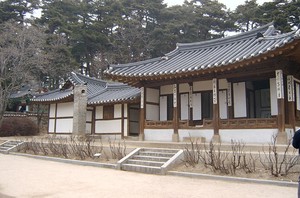
Characteristics
The environment-friendly aspects of traditional Korean houses range from the structure's inner layout to the building materials which were used. Another unique feature of traditional houses is their special design for cooling the interior in summer and heating the interior in winter.
Since Korea has hot summers and cold winters, the 'Ondol (Gudeul),' a floor-based heating system, and 'Daecheong,' a cool wooden-floor style hall were devised long ago to help Koreans survive the frigid winters and to block sunlight during summer. These primitive types of heating and air-conditioning were so effective that they are still in use in many homes today¹). The posts, or 'Daedulbo' are not inserted into the ground, but are fitted into the cornerstones to keep Hanok safe from earthquakes.
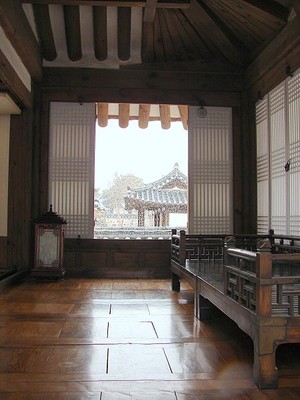
Materials
The raw materials used in Hanok, such as soil, timber, and rock, are all natural and recyclable and do not cause pollution. Hanok's have their own tiled roofs (Giwa), wooden beams and stone-block construction. Cheoma is the edge of Hanok's curvy roofs. The lengths of the Cheoma can be adjusted to control the amount of sunlight that enters the house. Hanji (Korean traditional paper) is lubricated with bean oil making it waterproof and polished. Windows and doors made with Hanji are beautiful and breathable.
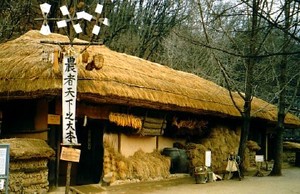
Regional differences
The shapes of Hanok differ regionally. Due to the warmer weather in the southern region, Koreans built Hanok in a straight line like the number 1. In order to allow good wind circulation, there are open wooden floored living area and many windows. The shape of the most popular Hanok in the central region is like letter "L" or Korean letter "ㄱ", an architectural mixture of the shapes in the northern and the southern regions. Hanoks in the cold northern region, are box-shaped like Korean letter "ㅁ" so that it would be able to block the wind flow in building Hanoks. They do not have an open wooden floored area but the rooms are all joined together.
Differences according to social class
The structure of Hanok is also classified according to social class. Typical yangban (upper class) houses with giwa (tiled roof) emphasized not only the function of the house, but also possess great artistic value. On the other hand, the houses of the commoners (as well as some impoverished yangban) with choga (a roof plaited by rice straw) were built in a more strictly functional manner.
January 1st. Seol Nal
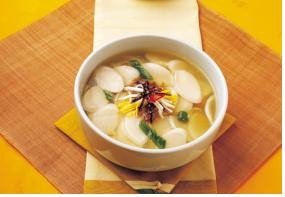
It's New Year's day in the lunar calender in Korea and it's the biggest holiday in Koea. Both South Korea and North Korea take 3 days holiday. People used to wear Hanbok (Korean traditional cloths). In this day, Koreans have a memorial service for ancestors in the early morning. Most of Koreans eat Tteokguk (rice cake soup usually with dumpling) in the morning. Eating Tteokguk means that people are getting older. We use white rice cake to make Tteokguk, because that means it represents a bright New Year. After that, people perform New Year's bows to their grandparents and parents. And children usually get New Year's gift money or words of blessings from them.
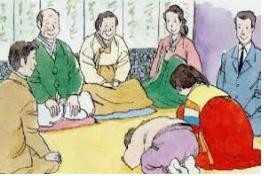
Yut-nol-e is the traditional folk game using 4 sticks. People throw Yut (sticks) and count which is overturned. Hwa-tu is the gambling card game which is actually originated from Japan. People play Hwa-tu a lot in holiday in Korea. And also people used to kiteflying in New Year's day.
January 15th. Jeongwol Daeboreum
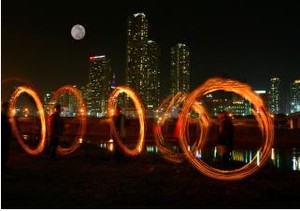
It's the 15th day of the New Year according to the lunar calendar. In this day, the first full moon appears. And moon viewing events are held in places. People thought that from this day, they can start the farm work. In Korea, moon symbols the yin, and it represents woman, richness. In this day, people usually eat Ogokbap (five grain rice) and bite on the nut to ward off the boils for a year. At night, people usually view the moon so they can read one year's farming fortune. If the moon is white, there will be a lot of rain this year, and if the moon is red it will be a year of bad harvest.
People usually do sheaf burning to wish to have a rich year. They burn the pile of branches when the moon rises in this day. Also, before Jeongwol Daeboreum day, people do Jwi-bul-nori. Which is making a fire in the farmland to wish to exterminate harmful insects, weeds.
April 8th. Buddha's birthday
In this day, roads near the temple are filled with lotus lantern. And lantern means to enlighten people. There's lot of religion in Korea, but Buddism has been existed in Korea for a long time, so it became the national holiday from unified Silla.
October 15th. Chu-seok
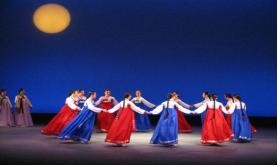
It's the second biggest holiday in Korea. In this holiday, people celebrate the harvest, remember their ancestors and share harvest with neighbors. After the harvest, people thank their ancestors by newly harvested rice and fruits. People have memorial ceremony for ancestors like New Year's day. It is 3 day holiday, so 75 % of Koreans visit their home during this holiday and it's often called en-masse migration. Because of that, during this day, train tickets or bus tickets are sold out very early. Koreans also call Chu-seok as Han-ga-wi. And they visit family member's grave in order to pay respects and thank for the harvest people made this year.
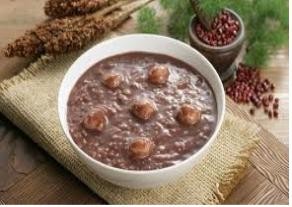
In Chu-seok, people play Tug-of-war, Ssireum (Korean wrestling), Ganggangsulae. Ganggangsullae is the Korean traditional circle dance play by woman under the bright moon. And people eat Song-pyeon like people eat Tteokguk in New Year's day. It's half-moon shaped rice cake stuffed with sesame seeds, sugar, sweet beans or chestnut filling. Some people make Song-pyeon with their family at home.
December 22th. Dong-ji
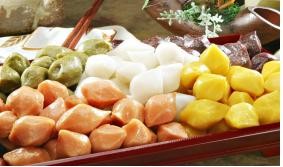
Dong-ji is the day when the sun's longitude becomes 270 degree. So it's night is the longest in the year and it's day is the shortest. Dong-ji is also called as ' a little version of New Year's day '. Because from this day, the sun rises again and means that spring will come.
In this holiday, people eat Patjuk which is red-bean porridge. Red color means it could make people safe from ghosts or bad luck because in history, people believed ghosts hate red beans
Haeundae District is a gu in eastern Busan, South Korea. It has an area of 51.44 km², and a population of about 423,000. This represents about 11.6% of the population in Busan. It became a division of Busan in 1976 and attained the status of gu in 1980.
Haeundae-gu can be reached easily on the subway, Busan Subway Line 2, or by train on the Donghae Nambu railway line from outside of Busan. Both Haeundae subway and train stations are built adjacent to each other.
Haeundae is an affluent beach front community that attracts tens of thousands of Korean tourists and foreigners to what many consider to be Korea's best beach. It has been subject to considerable commercial development in the past decades.
History
Haeundae takes its name from the ninth century Silla scholar and poet Choi Chi-won (literary name Haeun, or "Sea and Clouds"), who, according to a historical account, admired the view from the beach and built a pavilion nearby. A piece of Choi's calligraphy, which he engraved on a rock at Haeundae, still exists.
Haeundae used to be isolated from the large communities in Busan and Busanjin. It remained undeveloped, as did its beach, until the late 1970s and early 1980s. A small number of luxury hotels were constructed when new emphasis was placed on development of the area around the beach after the 1988 Seoul Olympics. More hotels and other tourist facilities have been constructed on the beach-front area since the mid-1990s, and shopping malls and movie theatre complexes have been built in the 'centre' of Haeundae: an area between Haeundae Station and the beach. The area's reputation and prosperity have continued to grow, except briefly during the Asian financial crisis of 1997.
Haeundae's geographical assets, along with its tourist facilities, have led to a regular role as one of the host venues for the annual Busan International Film Festival (BIFF), and Haeundae's Dongbaek Island was the location for the 2005 APEC Conference.
Haeundae New Town (해운대 신시가지-Haeundae Sinsigaji), a major commercial and residential redevelopment project begun in 1990, is located in the Jwa-dong area. This area lies in the southern shadow of Jangsan mountain to the north, and is bounded in the south by Haeundae Station on the Dalmaji Gogae line of the Korean National Railroad. Another development project, Centum City, has been ongoing since early 2000 and is now a major feature of Busan. Its BEXCO (Busan Exhibition and Convention Center) has become a popular venue for international conventions and exhibitions. Marine City, located nearby, is constructed on land reclaimed from the sea, and has several huge, high-rise apartment blocks. Additional apartment blocks, the most modern in Busan, are under construction, with water resorts and related facilities, for use by the public, also planned for Marine City.
Haeundae Beach
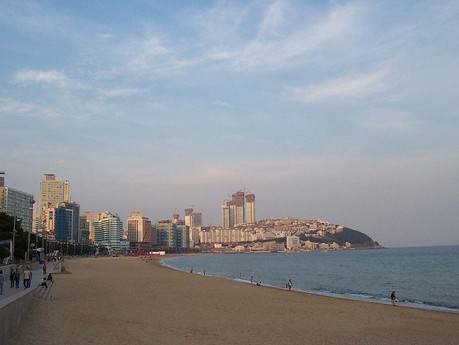
Haeundae Beach in Haeundae-gu is located at the southeast end of the city of Busan. Haeundae beach is only 40 minutes away from Busan's main railroad station (in the Downtown area), and less than one hour from Gimhae International Airport. Along the 12 km of coastline is Busan's most popular beach, and with Seogwipo's, it is one of the most famous beaches in South Korea. Because of its easy access from downtown Busan and the famous beach atmosphere, the beach is busy year round with several kinds of beach festivals and visitors from in and out from the country. Dongbaekseom (Dongbaek Island), located at the south end of the beach, offers a view of the sea by car and its coastline is famous for fishing. Oryukdo (Oryuk Islets), a symbol of Busan to many Koreans, can be seen in the distance from Dongbaek Island. During the hot summer months (late July to early August when most Koreans take their summer vacation), Haeundae beach becomes heavily crowded into a virtual human wall with thousands of people and parasols packed into a mile of sand. Visitors to the beach come from all over South Korea as well as outside of Korea. Haeundae is home to majority of expatriates currently residing in Busan.
There are many beach-related cultural events in Haeundae. Along with Geumjeongsan and Dalmaji (Greeting of the Moon) Gogae, Haeundae is one of the most popular spots in Busan to view the first sunrise of the year on January 1, with around a thousand gathering before dawn. Also, a famous beach event occurs in the first week of January when the temperature is around 0°C, the "Polar Bear Club." This event has occurred annually at the Choseon Beach Hotel since 1988. During the 2006 FIFA World Cup match between South Korea and Togo over 50,000 spectators filled the beach to cheer for the Korean team on a giant projector screen.[4] The Nurimaru, pure Korean meaning for Nuri (World) and Maru (Peak or top) was developed in preparation for the 17th APEC(Asia pacific Economic Cooperation) summit on Nov 18-19 in 2005, as the conference hall for APEC. The building is three-stories high and is located on the tip of Dongbaek Island. The ceiling of the Nurimaru is modeled after Seokguram, the famous Buddhist temple in Gyeongju.
Wish you could buy the extravagant things on your wish list at more affordable prices? With a little luck and some know-how, you can worry less about your budget and find your favorite brand items at 30-70% off the regular retail price. Keep reading to find out where you can purchase trendy, luxurious items without emptying your wallet.
Premium Outlets
Yeoju Premium Outlets
Yeoju Premium Outlets was jointly developed by Simon Property Group (a corporation from the USA) and Shinsegae Chelsea. It was the first original outlet in Korea and offers products at 25-65% off the retail price all year round. Among the 144 brands, you’re sure to recognize famous names such as Giorgio Armani, Bally, Burberry, Dior, DKNY, Fendi, Gucci, Marc Jacobs, and Max Mara. There are also stores that sell shoes, bags, accessories, children’s wear, and house wares. Most products are from previous seasons and popular items are only available in limited sizes, so it’s best to go the outlet with no particular “must-purchase” item in mind.
Paju Premium Outlets
Following the success of the Yeoju Premium Outlets, Paju Premium Outlets opened on March 18, 2011 in Paju. Stores include Nike, Gap, Tommy Hilfiger, Bean Pole, Adidas, Coach, Gucci, Marc Jacobs, Max Mara, and more. The outlet offers 25-65% discounts year-round on all of its 150 designer brands. The Adidas store is a real bargain with clothes and shoes selling at 60-80% off the regular retail price. Giorgio Armani offers most items at discounts of 50% or more, and some Armani t-shirts are even available in the 20,000 won range.
In addition to fashion stores, Paju Premium Outlets also has 13 house ware brands including Le Creuset and Tefal, as well as a LEGO store.
Lotte Premium Outlets
As the largest outlet mall in Korea, Lotte Premium Outlet Paju has international brand stores not available in other outlet stores in Korea, such as Paul Smith, Mulberry, TAG Heuer, and Kate Spade. There are also 320 other popular brand stores including Beanpole, Polo, MCM, Nike, and Adidas.
There is also a multiplex cinema equipped with state-of-the-art digital audio systems, a Pororo kid’s café for families with children, a park on the rooftop, and various restaurants. With nearby attractions such as the Unification Observatory, Heyri Art Village, and Paju English Village, visitors can tour around after or before shopping.
Outlets Specializing in Local Brands
Gimpo Airport Outlet
The Gimpo Airport Outlet is located in the international terminal of Gimpo Airport, where flights connect to destinations such as Tokyo, Haneda, Osaka, Nagoya, Shanghai, and Beijing. Gimpo Outlet has an upscale atmosphere that is almost like shopping in your favorite department store. Another major plus is that the outlet is easily accessible via Subway Lines 5, 9, and Airport Railroad Express (AREX). This way, you won’t have the hassle of lugging your heavy shopping bags through a bunch of transfer points.
The outlet offers 207 local brands and typically sells the previous year’s fashions at 30-70% off. You’ll also be able to find a selection of specially designed seasonal items (this year’s fashions) that are sold at around 30% discount. Check out the 1st floor to find women’s clothing, leather products, cosmetics, and jewelry shops. The 2nd floor has men’s clothing and sports & outdoor gear. Kids’ clothing and lingerie outlets, cell phone shops and restaurants can be found on the 3rd floor. The Louisienne, a premium outlet that opened in December 2010, carries brands like Michael Kors, Coach, and Etienne Aigner.
The outlet provides a tax refund service where you can receive a refund on VAT (Value Added Tax). For shoppers from China, the outlet also accepts China’s UnionPay credit card.
The Lotte Mall Gimpo Airport, located next to Gimpo Airport’s international passenger terminal, has a department store, multiplex cinema, supermarket, hotel, and exhibition hall, providing even more cultural activities and shopping.
Munjeongdong Outlet
Just take the subway to Munjeong Station, and you’ll soon find yourself on a wide street full of great products and top brands like Polo, Bean Pole, Levi’s, Quicksilver, Nike, Adidas, and Puma. Nike offers off-season items at 40% discounts, including clothing, sports shoes, and hats.
At the Munjeongdong Outlet, there are also other shopping malls like Mods Shopping Mall, and other local and overseas casual wear and luxury brands.
Mario Outlet
Spanning 132,000 square meters in Gasan-dong, Seoul, Mario Outlet is Asia’s largest urban hybrid (two functions or roles combined into one) outlet that carries about 500 brands. It was established in July 2001 as a fashion outlet store situated in the heart of downtown Seoul. Over the years, it has expanded into “Mario Outlet Town” by opening a second store (Mario 2) in 2004 and yet another one (Mario 3) in September 2012. As the outlet mall with the biggest scale and the largest number of brands in Asia, Mario Outlet offers a one-stop shopping experience and various cultural services. It features diverse shopping categories ranging from luxury brand items to clothes, accessories, cosmetics, furniture, and house wares, as well as premium restaurants, fast food restaurants, kids’ theme park, and more. By offering popular domestic brand products at discounts of up to 80%, Mario Outlet is rising as a reasonable shopping space for modern consumers who value “smart shopping”.
In addition to accepting cash payments in US dollars and Japanese yen for shoppers from abroad, Mario Outlet conducts affiliate marketing with China UnionPay credit card to make shopping convenient for Chinese shoppers who account for a large part of the sales. The outlet also provides tax refund services through which you can receive a refund on VAT (Value Added Tax) for purchases of over 30,000 won at Mario Outlet. Tax refund tickets are issued right off at the customer centers located on the Mario 1 seventh floor and the Mario 3 eleventh floor. Further shopping conveniences offered by the outlet include shopping information services exclusively for international tourists. Pamphlets containing the outlet’s shopping information are available in English, Chinese, and Japanese at the Mario 3 third floor information desk and throughout the mall.
Korea is starting to really embrace the idea of flea markets and second hand shops for gently used clothing and accessories. If you are looking for larger sizes or are in search of clothing with a more individualistic style, it’s recommended that you do some treasure hunting at one of the more popular weekend markets or shops. At first, it’s easy to be overwhelmed by all of the choices, but it’s worth a look and you may just find a diamond among all of the stones. Another plus to shopping second hand is that it’s incredibly cost-efficient. You can find the same leather jacket at a flea market for around 10,000 won ($9) that you would pay close to $100-150 for in a department store or boutique! Sizes are also very diverse and you can find both US and European sizes for most of the clothing being sold. Brand names are also mixed in with the non-branded items. High quality bags, shoes, jackets, sweaters, dresses, jewelery, etc. You can find it all at your local flea market or second hand shop.
Hongdae Free Market
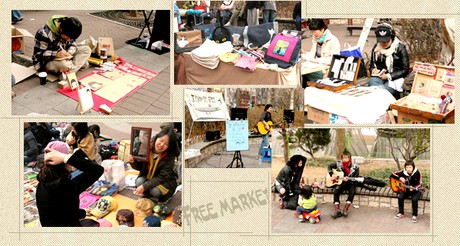
The Hongdae Free Market opens at 1pm every Saturday from March to November. Instead of used goods, you will find a variety of items handcrafted by college-age artists. The collection is quite extensive, ranging from hair ornaments crafted in Korean traditional needlework, to bags and hats with original, hand-drawn designs, shoes and diaries, and even music CDs just produced in a recording studio. You will also find portrait artists who will draw your caricature as well as impromptu musical performers. This place is vibrant with numerous things to see that are a pleasure just to see.
Artists who have registered with the Hongdae Free Market administration are permitted set up a stand or sell goods at the market. The ambience is much different from other markets, where you will find many unique, handmade crafts. If you want to see some young talent and passion, visit the Hongdae Free Market on a Saturday afternoon.
Seocho Saturday Flea Market

The Seocho Saturday Flea Market is located at the Bangbae-dong area in front of Sadang Station, Subway Line 2 & 4. It is one of the largest flea markets in Korea and sells all types of used goods except for food.
The market has clothing and accessories such as 500-won bags and 1,000-won T-shirts as well as electronic goods, antiques, and everyday goods. When buying an electric product, make sure to check the equipment before finalizing your purchase. The Seocho Saturday Flea Market is huge with thousands of participants, but there is no food on sale. To get something to eat, visit Yangjae’s market (across from the Seocho market) or Gangnam. Occasionally, simple snacks such as thick azuki bean soup and gimbap are sold at the flea market.
Gwanghwamun Flea Market
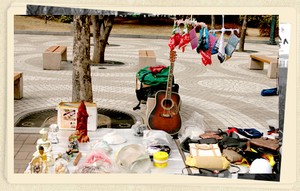
The Gwanghwamun Flea Market is on the way to Gyeongbokgung Palace. It is small but charming. The market hasn’t gained a lot of popularity yet, but when the weather is nice, there are many venders and visitors. The flea market is an interesting place to stop by when you are visiting palaces or other tourist sites in the area. The market is opened from 11 a.m. until 4 p.m. every Saturday. If you have anything to sell, you can register on site and pay a participation fee of 2,000 won.
There are many great places to visit in Gwanghwamun, all within walking distance: The Ubiquitous Dream Hall in front of the Gwanghwamun subway station, as well as Cheonggyecheon Stream or the galleries in Insa-dong and Samcheong-dong. Across from Simin Yulinmadang, where the flea market is located, are Gyeongbokgung Palace and the National Palace Museum of Korea. It is a convenient and worthwhile to combine Insa-dong, Gyeongbokgung Palace, Samcheong-dong, and Cheonggyecheon in one trip. Picture taking is prohibited on the way from Gwanghwamun station to Yulinmadang because the U.S. Embassy is located in between.
Philippine Market
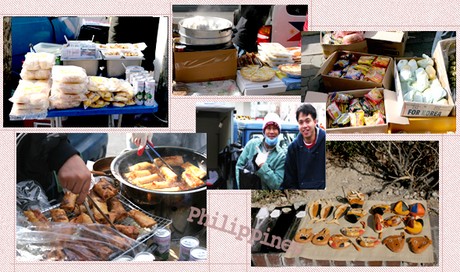
Every Sunday, Filipinos gather in a market in Hyehwa-dong to meet and chat with friends. The market sells groceries from the Philippines as well as magazines, and CDs, drawing both Filipinos and Korean clients. This flea market is especially unique in that it offers a rare opportunity to experience the local culture of the Philippines. If you want to experience Philippine culture in Seoul, visit Hyehwa-dong’s Philippine Market from 12 p.m. to 6 p.m. on Sundays.
While the main sales are groceries, the market also offers foods made on the spot, pojangmacha foods, ramyeon, and snacks. The prices are relatively low: a banana fritter wrapped in thin dough is 1,000 won and 3 mangos cost 5,000 won. If you want to try the cuisine of the Philippines, be sure to visit the market with an empty stomach.
Only the most famous and well-known markets are suggested to travelers. And for good reason. They’re huge and have lots to see. But if you want to get a glimpse into the life of how local Koreans live, check out the 13 traditional markets in Seoul that only Seoul locals know about in the next pages. But just in case you didn’t know, here are all the markets that the guidebooks and Korea travel sites recommend. These markets are themselves tourist attractions. Their products range from clothes, food, fabrics, electronics, beef and everything in between. At some of these markets, you can literally spend an entire day shopping, bargaining, eating and people watching. Come here and get lost.
Namdaemun Market
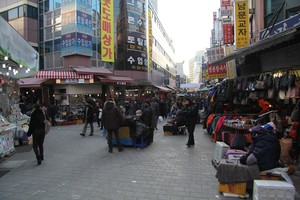
This is one of the oldest markets in Seoul, and anyone coming to Seoul should know this one. Namdaemun Market is a place where you can buy Korean style metal utensils and bowls, art supplies, Korean style pillows, Gangnam Style socks, anti-cancer ginseng, eyeglass frames, camera parts and everything in between. It’s that huge. It’s the perfect place to buy souvenirs and also to have fun getting lost. The most famous things to eat here are mackrel broiled in red pepper sauce (고등어조림) and knife cut noodles (칼국수). Also, there are grannies in the middle of the market who are rumored to give the best exchange rates (but they’re also famous for being mega mean!).
Gwangjang Market
This 100+ year old market is a fabric and textile market. And although you can buy your own custom made hanbok (traditional Korean clothes) here, most tourists come here to eat the really good food at the stalls in the middle of the market. It’s a very genuine market eating experience complete with gritty ajummas (Korean ladies). One of the two famous dishes in this market is mungbean pancakes (빈대떡), which is pretty bomb with a bottle of soju or makkeolli on a cold winter night (also good if you’re by yourself acting out a dramatic scene from a Korean drama). If you’re just into snacking, try mayak gimbap (마약김밥) aka “drug” gimbap. It got the nickname because they’re THAT addicting.
Noryangjin Fish Market
Weird sea creatures always make people ooh and ahh. But here, you can say ooh and ahh and then stick it in your mouth 10 minutes later. Pick a fish, octopus, sea cucumber, scallop, crab, whatever your fancy, and have the vendor slice it up for you. Bring it to one of the restaurants next door and start eating it raw or have the restaurant cook it. (See the whole process with Seoulistic’s video!). The market’s also really cool because it’s open super late too. So you’ll see salarymen coming in at afterwork hours, and once past midnight Seoul night owls will start to pour in.
Garak Market
Garak Market is the main wholesale market of Seoul, and it is crazy huge. More than 100 thousand people go to this market everyday, so you might get lost in the crowd. If you’re going with babies, make sure you put on one of those really useful, but kind of strange-to-see baby leashes. It’s a lot of fun to see the auctions, but to avoid the biggest crowds, don’t go at night. Around after 9PM, people start pouring in to do their shopping for the gajillion restaurants in and around Seoul. If you’re visting at that time, make sure you have your own baby leash. Also, if you’re buying produce, bring friends to get the cheapest discounts.
Dongdaemun Market
This might be the sole reason some of you come to Korea: To shop, shop, shop for Korean fashion! And that’s a really good reason. Korean fashion here is cheap, unique, up to date and also open mega late (closes at approximately 7AM). So it doesn’t matter if your schedule is packed, just go to the clothes market late at night and start your shopping spree. Also, come here for the really good street food and the Korean drama style tent bars (pojangmacha / 포장마차).
Geumcheongyo Market
Most tourists will flock to the Royal Palace (Gyeongbok-gung) to throw up V-signs in pictures with the royal guards. After that, most tourists will also head over to Tosokchon (토속촌), a super famous Samgyetang restaurant (chicken soup). But if you want to avoid possible lines, you can check out what Korea was like in the 1960′s at Geumcheongyo Market nearby. It’s very small and super local, so there probably won’t be much shopping for tourists. But there are definitely eats. Also, you might want to check out how tteokbokki (rice cake) was made long ago; it’s fried in a wok with some oil and red pepper (today it’s cooked in a red soup).
The Boryeong Mud Festival is an annual festival which takes place during the summer in Boryeong, a town around 200 km south of Seoul, South Korea. The first Mud Festival was staged in 1998 and, by 2007, the festival attracted 2.2 million visitors to Boryeong.
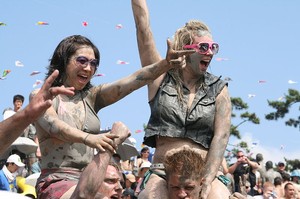
The mud is taken from the Boryeong mud flats, and trucked to the Daecheon beach area, where it is used as the centrepiece of the 'Mud Experience Land'. The mud is considered rich in minerals and used to manufacture cosmetics. The festival was originally conceived as a marketing vehicle for Boryeong mud cosmetics.
Although the festival takes place over a period of around two weeks, it is most famous for its final weekend, which is popular with Korea's western population. The final weekend of the festival usually falls on the second weekend in July.
History of the Festival
In 1996 a range of cosmetics was produced using mud from the Boryeong mud flats. The cosmetics were said to be full of minerals, bentonites, and germaniums, all of which occur naturally in the mud from the area.
In order to promote these cosmetics, the Boryeong Mud Festival was conceived. Through this festival, it was hoped people would learn more about the mud and the cosmetics. The festival has become popular with both Koreans and western tourists, as well as American Military personnel stationed in the country, and foreign English teachers working in Korea.
The festival attracted some controversy in 2009 when a group of school children attending the festival developed skin rashes after contact with the mud
Attractions
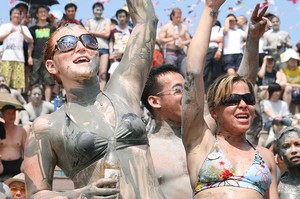
For the period of the festival several large attractions are erected in the seafront area of Daecheon. These include a mud pool, mud slides, mud prison and mud skiing competitions. Colored mud is also produced for body painting. A large stage is erected on the beach, which is used for live music, competitions and various other visual attractions.
A small market runs along the seafront selling cosmetics made using the mud from Boryeong. Various health and beauty clinics offer massages, acupuncture and other treatments utilising the medicinal qualities of the mud. The festival is closed with a large firework display.
Bang is a romanization of the Korean word 방, meaning 'room'. In a traditional Korean house, a sarangbang (Hangul: 사랑방; Hanja: 舍廊房) is the man's study or drawing room, for example.
In modern Korea (especially in the South), the concept of a bang has expanded and diversified from being merely a walled segment in a domestic space, to including buildings or enterprises in commercial, urban, space, such as a PC bang (an internet café), a noraebang (a karaoke room), sojubang (a soju room, i.e. a pub), manwhabang ("manwha room", where people read or borrow manwha) and a jjimjilbang (elaborate Korean public bathhouse). This can be compared with the similar expansion of the concept of a 'house' to include upper houses, opera houses, coffee houses, and publishing houses. Below are a few of the most popular:
PC-bang
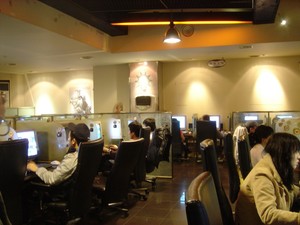
A PC bang (Korean: PC방; literally "PC room") is a type of LAN gaming center, where patrons can play multiplayer computer games for an hourly fee. The typical cost for an hour of play ranges from 500 to 1500 won (approximately $0.44 to $1.32 USD.), with 1000 won per hour being the most common cost. Although the per capita penetration of computers and broadband internet access is very high in South Korea, PC bangs remain popular as they provide a social meeting place for gamers (especially school-aged gamers) to play together with their peers. Furthermore, the computer hardware used by PC bangs may be more powerful than the systems available in the players' homes. Most PC bangs allow players to eat, drink and smoke (often with separate smoking and non-smoking sections) while they play. It is common for PC bangs to sell ramen noodles, canned coffee, soft drinks, and other snacks.
PC bangs rose to popularity following the release of the PC game StarCraft in 1998. In 1997, there were only around 100 PC bangs in South Korea but by 2002 this number has increased rapidly to around 25,000. Although PC bangs are used by all ages and genders, they are most popular with male gamers in their teens and twenties.
Many popular Korean multiplayer games provide players with incentives which encourage them to play from a PC bang. For example, the Nexon games Kart Rider and BnB reward players with bonus "Lucci" — the games' virtual currencies — when they log on from a PC bang.
Noraebang
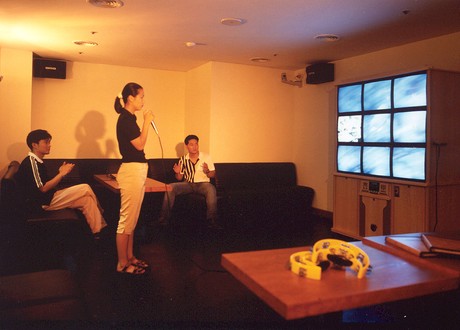
These “singing rooms” are all over the country, even outside national park entrances, and are wildly popular with people of all ages; if you have any Korean friends, they’re bound to invite you to one before long, as noraebang are usually sam-cha in a Korean night out – the “third step” after meal and drinks. The system is different from what Westerners usually expect of a karaoke room – you don’t sing in front of a crowd, but in a small room with your friends, where you’ll find sofas, a television, books full of songs to choose from and a couple of maracas or tambourines to play. Foreigners are usually intimidated at first, but after a few drinks it can be tough to get the microphone out of people’s hands. Figure on around W15,000 per hour between a group.
Jjimjilbang
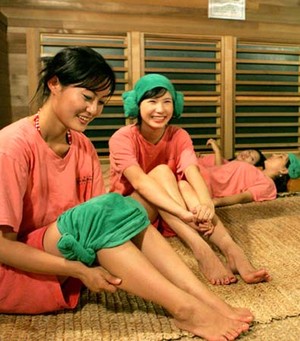
A Jjimjilbang (찜질방) is a large, gender-segregated public bathhouse in Korea, furnished with hot tubs, showers, Korean traditional kiln saunas and massage tables. Jjimjil is derived from the words meaning heated bath. However, in other areas of the building or on other floors there are unisex areas, usually with a snack bar, ondol-heated floor for lounging and sleeping, wide-screen TVs, exercise rooms, ice rooms, heated salt rooms, PC bang, noraebang, and sleeping quarters with either bunk beds or sleeping mats. Many of the sleeping rooms can have themes or elements to them. Usually Jjimjilbangs will have various rooms with different temperatures to suit guests' preferred relaxing temperatures. The walls are decorated with different woods, minerals, crystals, stones, and metals. This is to make the ambient mood and smell more natural. Often the elements used have traditional Korean medicinal purposes in the various rooms.
Most jjimjilbangs are open 24 hours and are a popular weekend getaway for Korean families. During the week, many hardworking Korean men, whose families live out of the city for cost savings, stay in Jjimjilbangs overnight after working or drinking with co-workers late into the night; the cost is 6,000-10,000 Korean won to enter, and one can sleep overnight, enjoy the bathhouse and sauna, and wake up fresh and ready to travel the next morning. Jjimjilbangs are also popular with Korean women, and traditionally, Korean mothers used to take care of themselves in rooms made of loess (called "Yellow Mud" in Korean) for three weeks before giving birth.
Orientation
Jjimjilbang usually operate 24 hours a day. In front of the entrance, there are the doors titled “men” or “women” and shoes are to be stored using a given key. Once inside, the shoe locker key is to be exchanged with another locker key to store clothes and belongings. Afterwards bathers walk into the gender-segregated bathhouse area and take a shower. Then, it is supposed to be dressed in jjimjilbang clothes (usually a T-shirt and shorts) received with the locker key.
In a bathing area, there are different kind of kiln saunas with a varying themes including a jade kiln, a salt kiln, a mineral kiln: the dome-shaped inside walls of klin rooms are plastered with jade powder, salt and mineral respectively. and a series of kiln with different temperatures ranging from 60 to 100 degrees Celsius. The temperature sign outside the kiln is given before the entrance.
Jjimjibang Culture-Sheep Head
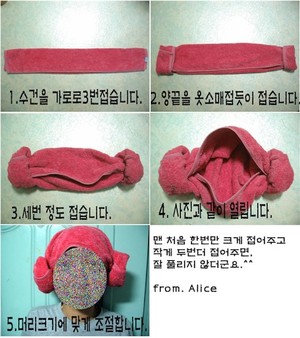
It is common that people in Korea wear sheep-shape towel in Jjimjibang. Steps of Making "Sheep Head":
1. Fold towel length-ways 3 times
2. Fold the ends over themselves until secure
3. Turn over and find opening
4. Pull opening apart till head sized
5. Place on head
Others
DVD-bang
Imagine a small room with wipe-clean sofas, tissue paper on hand and a large television for movies – if it sounds a little sleazy, you’d be absolutely right. Though people do occasionally come to appreciate plot, cinematography or Oscar-winning performances, these places are more often used by couples looking for a cheap bit of privacy – going in by yourself, or with a person of the same sex would draw some baffled looks. Figure on around W11,000 per movie..
Game-bang
Filled with all manner of board-games, these rooms underwent a surge in popularity just after the turn of the millennium – a strange development, considering the country’s love for digital forms of entertainment – but don’t see many foreign guests. Note that they’re not really for kids, being café-style places better suited to young couples.
Korean Palaces, the heart of old city
Korea's precious architecture heritage which connects the past and present
Palace is the place where king works and live. In Seoul, which is capital of Korea and was called Han Yang before, there are 5 palaces. Gyeongbok Palace, Changdeok Palace, Deaosu Palace, Gyeonghui Palace, Changgyeong Palace. And each palaces have their own characteristics so it will be a great experience for you to visit those palaces.
Gyeongbok Palace : the Best palace in Chosun Dynasty
Gyeongbok palace is the best palace of remaining 5 palaces in Seoul. Gyeoungbok means that new dynasty will bring good luck and prosper for long time. It was the center of Chosun dynasty, it's scale is different from others. The length of the wall is 2404m in total, and it has 4 main gates compared to other palaces. And it has administrative offices where king and government official administer the affairs of state, Jung Gung (where queen stayed), Dong Gung (where crown prince stayed), Nae Jeon (where court lady stayed), etc.
Gyeongbok palace built completely 1395, when 3 years after Chosun dynasty started. It was rebuilded, expended for several times, and burned entirely because of the Japanese invasion of Korea in 1592. There was no restoration work for 270 years and in 1867, regent Heungseon Daewongun tried to rebuild it, but unfortunately, the palace ruined again during the Japanese colonial era. The Gyeongbok palace today, is the result of hard work to rebuild and protect our cultural heritage from 1990. It has been with Koreans even though there were so many national tragedies, the palace still has the history of Seoul and Chosun dynasty.
-> Traveling tip
Gyeongbok palace is so huge, if you want to see all of it, you need to take 2-3 hours at least. You can also find english map at the entrance. The main gate's name is Gwanghwamun. And there's changing of the Guards ceremony in front of it. You should not miss it.
* Every Tuesday the palace is closed.
* There's free english/japanese/chinese tour
*to get more detailed information : royalpalace.go.kr
Deoksu Palace : Harmony of Korean and Western Culture
Unlike other palaces that are placed in front of mountain, Deoksu Palace is placed in the middle of downtown. Also, it's the only palace in Seoul which close at night. And it's night sight is really beautiful. Inside the palace, there are lots of interesting places like Deoksu Museum, King's library, Junggwanhun (where emperor Gojong used to drink coffee and had banquet).
Deoksu palace was actually a house of king Seongjung's brother. It became a palace where king Seonjung stays after all palaces were burned because of Japanese invasion of Korea. After that, king Gwanghae named it Gyungown palace, it became detached palace of Chosun dynasty. After 1900, western style buildings were added and became a palace which tradition and modern makes harmony. The size of palace get small because of Japanese colonial era, and changed the name to Deoksu palace. The park inside the palace which was made to share with people became student's field trip place and the place where people get peace.
* opens 9:00 ~ 21:00
* to get more information : deoksugung.go.kr
Changdeok Palace : with nature
If Gyungbok palace shows us the majesty of king's dignity, in Changdeok palace you can feel like you are in nature. You can feel cozy and friendly inside. It was built in 1405, and it's the best palace which shows the very Korean. It was build not to be so artificial, but to assimilate with nature. If you walk inside the palace, you can feel like you are walking in the oriental painting.
Whowon is the highlight of Changdeok palace. There are beautiful summerhouse inside valley. To preserve the nature, only people who made a reservation can get inside.
* for more information : www,cdg.go.kr
Changgyeong Palace : the Last word of King's life
To extend Changdeok palace's place, Changgyeong palace was made. So two palaces were used as one palace without boarder before, and that was called Donggwal. Changgyeong palace is charming and simple. Because lots of royal families lived here, many historic events happened here like Heebin Jang story. This palace also degraded to park which was for amusement because of the Japanese colonial era.
-> Traveling tip
* there's 100 year old great glasshouse inside the palace
Gyunghui Palace : trace of Royal family
It's small palace compared to other palaces. Only a few buildings and the building sites are left. It was build in 1623. Gyunghui palace was actually a place for king Injo's father, but because one psychic said that a royal standard was clouded in that place, king Gwanghae believed it and took the place and made to a palace.
Before there was a big fire in 1829, the palace had 1500 rooms. And it lost it's vestige of palace because Japanese used this place as a school in colonial era. After this, buildings in palace forced removal and became smaller.
-> Traveling tip
* You can follow a trail if you walk stairs where's at right of Gyunghui palace. You can see Namsan tower, a path through a forest.
* for more information: 02-731-0531
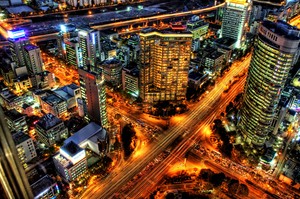
Seoul is certainly one of the most lively and dynamic nightlife capitals of the world. Even after midnight, throngs of people wander the streets in major shopping districts and popular downtown areas. The top attractions at nighttime are Dongdaemun Market for late-night shopping and the Hongik University (Hongdae) neighborhood with its concentration of nightclubs. For fabulous night views of Seoul, visit the observatory in N Seoul Tower or 63 City on Yeouido Island. Many visitors enjoy 63 City’s museums and dining facilities in the afternoon and stay past sunset to catch a glimpse of Seoul at night from high above in the skyscraper. If traveling with children, some options include recreational parks that open until 8 or 9pm or an exciting non-verbal show. Those with an interest in Korean traditional liquor can try some of the establishments serving Korean makgeolli.
Dongdaemun Market
In the evening, as soon as visitors exit Dongdaemun Station (Subway Line 1 & 4) or Dongdaemun History & Culture Park Station (Subway Line 2, 4 & 5), they’ll find themselves a party to one of Seoul’s busiest street scenes. The area around Dongdaemun is more than just a great shopping venue; it’s the perfect place to experience some of the fun that the city has to offer.

Fridays at Migliore
Glittering neon signs and loud music wakes up sleepy souls as people start crowding the streets of Dongdaemun. An outdoor stage surrounded by giant fashion malls (Doota, Migliore, Hello apM, and Good Morning City) is a spot for regular dance performances, concerts or other exciting events. Even though the night is young, thousands of young men and women are already swarming down the fashion street that runs past the various shopping malls. The bustling, splendid night has only just begun.
Nighttime Stroll along Cheonggyecheon
Visitors often start their walk along Cheonggyecheon at Dongdaemun. Connected to the Han River, Cheonggyecheon is a stream over 3.7 kilometers long that runs right through downtown Seoul. Though once a stream that was hidden underneath the road, it was restored to its original form in 2003, redefining the landscape of Seoul. Getting more beautiful at night with the addition of lighting in some places and laser displays in others, a walk along Cheonggyecheon is the perfect complement to a night out on the town.
Fashion Leaders Converge at Dongdaemun
As the evening goes on, the number of shoppers increases in Dongdaemun. Bored by seeing the same-old brands in department stores, visitors come here to browse among the fresh creative new looks at shopping malls such as Doota, Migliore, Hello apM, and Good Morning City. These fashion hotspots are among the first places to receive new merchandise, showcasing the fashion industry’s latest masterpieces. Cheaper than those in department stores, clothes in Dongdaemun are sold 24 hours a day. Even though the malls mainly sell clothes, they also have a variety of other products scattered throughout, including: stationery, food, souvenirs, and products for children. There is even a movie theater.
The Yellow Tents of the Open Market
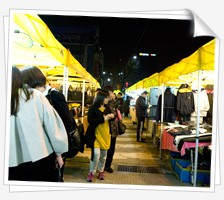
Early in the evening, while the area’s giant shopping malls are crowded with customers, the Open Market near Exit #4 of Dongdaemun History & Culture Park Station (Subway Line 2, 4 & 5) waits quietly until 10:00 pm before finally revealing its glory in a glitter of sparkling lights. The Open Market boasts endless rows of yellow tents selling clothes, leather goods, glasses, shoes, bags, and other accessories at majorly discounted prices. Although it lost some of its commercial luster after the nearby shopping malls popped up, it still draws people looking for that extra something special in Dongdaemun.
Wholesale Clothing Town
Dongdaemun gets even busier after midnight. Retailers from across the country gather in the Wholesale Clothing Town to do business alongside the droves of older international travelers that have come to sightsee. Across from the shopping malls, the Wholesale Clothing Town is like a huge warehouse that sells virtually every type of clothing made in Korea. Retailers waiting in front of wholesale shops such as Nuzzon, Yours, and Designer Club with large bags are a common scene at night in Dongdaemun.
Delicious Late-Night Snacks
It’s natural to get hungry when shopping in a large place like Dongdaemun. The late-night snacks sold at street stalls, in addition to the shopping, are yet another reason why people congregate here. Around Gwanghui Market and Jeil Pyeonghwa Market, numerous street stalls sell a variety of foods such as toast, hamburgers, dumplings, tteokbokki (stir-fried rice cake, vegetables and fish cakes in gochujang (red chili paste) sauce), fish cakes, and tteokgalbi (grilled beef and pork with a sweetened soy sauce marinade). In the early morning, the streets are filled with the lively sound of friends meeting and talking over soju (Korean distilled alcohol) and eating savory sundae gopchang (cow or pig’s intestines stuffed with various ingredients and fried with spicy sauce). Although the appearance of the nearby shopping malls led to the reduction of street stalls selling late-night snacks, many street vendors still stand proud, adding the delicious smell of their wares to the warm night air. Dongdaemun’s mix of fun and flavors is a rarity that can’t be found anywhere else in Seoul.
Night View of Seoul
N Seoul Tower
Atop Namsan Mountain (262 meters) in the heart of Seoul stands N Seoul Tower (236 meters). Completed in 1969, this beloved city landmark has come to represent the city itself and has been Seoul's most visited observation deck for several decades. The tower itself is a major attraction as it is brightly illuminated in the evening. The tower is lit blue when the dust density in the air is 45㎍/㎥ or lower, and white when greater than 45㎍/㎥. To get to N Seoul Tower, start at the Namsan Mountain cable car. After reaching the tower, visit the outdoor terrace and observation deck for a panoramic view of Seoul. Also be sure to spend some time with the adorable teddy bears at the Teddy Bear Museum.
For a 360 degree view of Seoul, take the elevator to the observatory. There are several restaurants and cafés on the first through fifth floors. The upscale n•GRILL seems to attract guests celebrating special occasions, while the Korean restaurant HANCooK caters to family visitors. For those who are skipping dining, there is also an observatory café for coffee and pastries, and on the second floor (T2), simple snacks and beverages are also available. Also, don't miss the famous Sky restroom with a view.

Tteok is a class of Korean rice cakes made with glutinous rice flour (also known as sweet rice or chapssal), by steaming. Normal rice flour can be used for some kinds of tteok. There are hundreds of different kinds of tteok eaten year round. In Korea it is customary to eat tteok guk (tteok soup) on New Year's Day and sweet tteok at weddings and on birthdays. It is often considered a celebratory food and can range from rather elaborate versions with nuts and fruits down to the plain-flavored tteok used in home cooking. Some common ingredients for many kinds of tteok are mung bean, red bean, and sweet red bean paste, Korean mugwort, jujube and other dried fruits, sesame seeds and oil, sugar, and pine nuts.
Types
Tteok is largely divided into four categories, such as "steamed tteok", "pounded tteok", "boiled tteok" and "pan-fried tteok". The steamed tteok is made by steaming rice or glutinous rice flour in "siru" (시루), or a large earthenware steamer, so it is often called "sirutteok". It is regarded as the basic and oldest form of tteok. The pounded tteok is made by using a pounding board or mortar after steamed first. In making pan-fried tteok, the rice dough is flattened like a pancake and pan-fried with vegetable oil. The shaped tteok are made by kneading a dough with hot water which is usually shaped into balls.
Steamed tteok
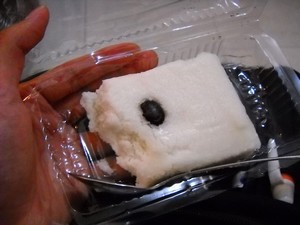
The main ingredients for steamed tteok or "sirutteok" are rice or glutinous rice and sometimes they are mixed together. In some cases, other grains, beans (azuki beans or mung beans), sesame seeds, wheat flour, or starch can be mixed with the rice. Various fruits and nuts are used as subsidiary ingredients, such as persimmons, peaches or apricots, chestnuts, walnuts, and pine nuts. In addition, vegetables with flavors or herbs can be used to flavor the tteok. Danggwi leaves (Ostericum grosseserratum), seogi mushroom (manna lichen), daikon, artemisia, pepper, and cheongju are the most common flavorings, and honey and sugar are used as sweeteners.
Baekseolgi is a kind of rice cake (tteok) made of rice flour dough. It is originated in Korea and a prime part of Korean culture. A Baekseolgi contains rice flour, sugar, and salt. It is usually eaten on the special occasions among Korean people, for example on the 21st birthday of a member of the family or on the 100th day of the death. The cakes are colored white, a colour that symbolizes purity and holiness. Because of the special occasions they are eaten, the cakes are never shared with neighbors or friends, but only with family members.
Pounded tteok
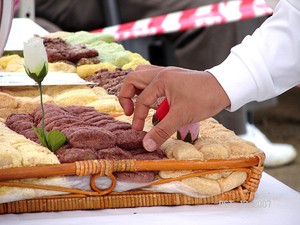
In the traditional preparation, pounded tteok is made by pounding rice or glutinous rice with utensils called jeolgu and jeolgutgongi or tteokme and anban. Injeolmi, garaetteok, jeolpyeon and danja are commonly eaten pounded tteok.
.Injeolmi is a variety of tteok, or Korean rice cake, made by steaming and pounding glutinous rice flour, which is shaped into small pieces and usually covered with steamed powdered dried beans or other ingredients.
Not only are you always within minutes of a restaurant anywhere in all Korean towns and cities, you don’t even have to move from where you are to get a meal. If you can describe the location you are at sufficiently enough in Korean, then you can probably get a local restaurant to deliver food to you. This is inclusive of all areas accessible my a small motorcycle.
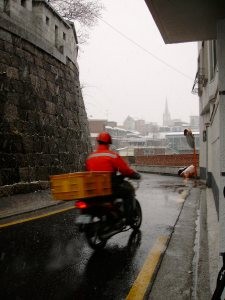
People in recreational areas such as the riverside parks along the river will often find a restaurant menu pinned to a pillar or park bench, call it and get food delivered to them, at no extra cost. If a road heads up a mountain, and you’re hungry at the top, then, within reason, you can probably get some food delivered to you. One of the unique perks of Korea is this fantastic level of service which operates on a whole other level.
Types of Food Delivery
China food adopted from Koreans
 Jjajangmyeon(blackbean noodles) is one of the most popular dishes in South Korea. It consists of wheat noodles served with a black and sweet sauce called chunjang, made from roasted soybean, thickened with cornstarch and sweetened with caramel. The sauce can be prepared in many ways: the vegetarian version is prepared with carrots, cucumber, courgettes, onion and other vegetables while the non-vegetarian version also include pork, beef or seafood like squid and shrimps but not fish. The taste is very rich and the contrast of flavours is enjoyable. The thickness of sauce (due to the starch) are a perfect match for the chewy noodles. Pickled radish and raw onion are the selective side dishes for Jjajangmyeon and are meant to refresh your palate.
Jjajangmyeon(blackbean noodles) is one of the most popular dishes in South Korea. It consists of wheat noodles served with a black and sweet sauce called chunjang, made from roasted soybean, thickened with cornstarch and sweetened with caramel. The sauce can be prepared in many ways: the vegetarian version is prepared with carrots, cucumber, courgettes, onion and other vegetables while the non-vegetarian version also include pork, beef or seafood like squid and shrimps but not fish. The taste is very rich and the contrast of flavours is enjoyable. The thickness of sauce (due to the starch) are a perfect match for the chewy noodles. Pickled radish and raw onion are the selective side dishes for Jjajangmyeon and are meant to refresh your palate.
The origin of this dish are from China, but there are many differences. The Chinese version is more simple, including usually just pork, bean paste and sliced cucumber and the sauce is salty. After Jjajangmyeon was introduced to Korea, it was modified according to Korean taste and it was served for special occasions like weddings or birthdays. Things have changed in the last 30 years and it has become a casual dish. You can find many Jjangmyeon shops all over Korea and it can be ordered and delivered at home. After ordered it you will receive it within 30 minutes and after have consumed it, you can leave the bowl and cutlery outside of your step door for the delivery guy to take it back. Of course Jjajangmyeon is also available in instant packet in every convenience store.
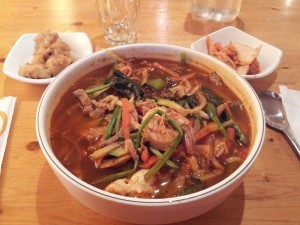
Jjampong(noodles in spicy seafood broth) it’s a dish that was originally created in China but that has been adapted in Korea and that has become a very popular dish as much as Jjajangmyeon . As Jjajangmyeon, it is reasonably cheap and filling, making it a perfect meal for students. It is usually served in Chinese restaurants in Korea as well as take away and the funny thing is that if you are outside Korea, you will find this dish mostly in Korean restaurants and not in Chinese ones.
Jjampong consists in a stew of seafood such as shrimps, octopus or sea shells cooked together with vegetables and served with wheat noodles. Vegetables include green onion, carrots, ginger, cabbage and mushrooms. The peculiar thing about this dish is that the recipe is very flexible and the ingredients can change a lot according to their availability and to the country and it can also include meat. When I was in Canada, I tried a Jjampong prepared using squids, shrimps, octopus and clams as seafood and sliced pork as meat. The vegetables used were mushrooms, spinach, onion, green peppers and carrots. The spiciness to the dish was given by the red pepper flakes added.
Korean Fried Chicken
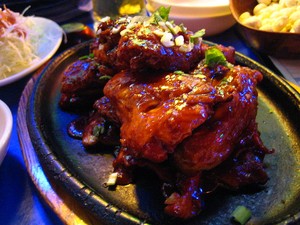 Korean fried chicken or seasoned chicken(yangnyeom chicken) is a fried chicken dish prepared in a Korean style. It is consumed as a meal, fast food at bars, or as an after meal snack in Korea. Korean fried chicken differs from typical American fried chicken by being fried twice. This results in the skin being crunchier and less greasy. Furthermore, Korean-style chicken is not characterized by the crags and crusty nubs associated with American fried chicken as described by Julia Moskin of The New York Times as a "thin, crackly and almost transparent". The chickens are usually seasoned with spices, sugar, and salt, prior to and after being fried. Korean fried chicken restaurants commonly use small or medium sized chicken, in other words, younger chickens resulting in more tender meat. Pickled radishes, beer, and soju are often served with Korean fried chicken.
Korean fried chicken or seasoned chicken(yangnyeom chicken) is a fried chicken dish prepared in a Korean style. It is consumed as a meal, fast food at bars, or as an after meal snack in Korea. Korean fried chicken differs from typical American fried chicken by being fried twice. This results in the skin being crunchier and less greasy. Furthermore, Korean-style chicken is not characterized by the crags and crusty nubs associated with American fried chicken as described by Julia Moskin of The New York Times as a "thin, crackly and almost transparent". The chickens are usually seasoned with spices, sugar, and salt, prior to and after being fried. Korean fried chicken restaurants commonly use small or medium sized chicken, in other words, younger chickens resulting in more tender meat. Pickled radishes, beer, and soju are often served with Korean fried chicken.
Bossam
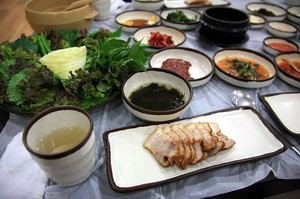 Bossam is a type of ssam in Korean cuisine in which steamed or roasted pork is wrapped in a leaf vegetable such as red lettuce or sesame leaf, often accompanied by condiments known as ssamjang or gochujang. It can even be wrapped in a kimchi leaf. It is usually topped with raw or cooked garlic, onion, freshly made kimchi, saeujeot (pickled fermented shrimp), or other pickles. Bossam is a popular dish in Korea, and can also be served as an anju (side dish consumed while drinking alcoholic beverages). Bossam's origins are closely linked to kimchi. During the gimjang season, when large quantities of kimchi were made, noblemen gifted a pig to the kimchi makers to boost their spirit, as the process required hard work and dedication. The pig was steamed and eaten with freshly made kimchi. Pork meat is boiled in a broth that contains ginger and onions to reduce the smell. Bossam is often eaten with oyster on top of the meat, this variety is called gul bossam. Gul bossam restaurants also provide gamjatang (potato soup), which is traditionally eaten first.
Bossam is a type of ssam in Korean cuisine in which steamed or roasted pork is wrapped in a leaf vegetable such as red lettuce or sesame leaf, often accompanied by condiments known as ssamjang or gochujang. It can even be wrapped in a kimchi leaf. It is usually topped with raw or cooked garlic, onion, freshly made kimchi, saeujeot (pickled fermented shrimp), or other pickles. Bossam is a popular dish in Korea, and can also be served as an anju (side dish consumed while drinking alcoholic beverages). Bossam's origins are closely linked to kimchi. During the gimjang season, when large quantities of kimchi were made, noblemen gifted a pig to the kimchi makers to boost their spirit, as the process required hard work and dedication. The pig was steamed and eaten with freshly made kimchi. Pork meat is boiled in a broth that contains ginger and onions to reduce the smell. Bossam is often eaten with oyster on top of the meat, this variety is called gul bossam. Gul bossam restaurants also provide gamjatang (potato soup), which is traditionally eaten first.
Jokbal
 Jokbal is a Korean dish consisting of pigs' feet cooked with soy sauce and spices.[1] It is usually served in dark braising liquid, made from soy, ginger, garlic, rice wine. The hair is removed from pigs' feet and they are thoroughly washed. Leeks, garlic, ginger, cheongju (rice wine) and water are brought to a boil. The pigs' feet are added, brought back to a boil and then simmered until tender. Then additional water, sugar and soy sauce are poured into the pot and the contents are slowly stirred. Once the jokbal is fully cooked, bones are removed, and the meat is cut into thick slices. It is then served with fermented shrimp sauce called saeujeot.As jokbal is usually shared with several other diners, it is usually served in large portions on a platter. Due to its unique greasiness and strong flavor, jokbal is eaten like other Korean grilled meats - wrapped in lettuce with other vegetables by hand before it is eaten. As jokbal is considered an anju, it is often eaten with soju as well as other anjus such as Bindaetteok. Full with gelatins, jokbal is said to be good for skin and preventing wrinkles. The amino acid of methionine in pork is known to detoxicate alcohol, and prevents hangovers. It is also considered good for the detoxication of toxins due to silicosis and heavy metal poisoning.
Jokbal is a Korean dish consisting of pigs' feet cooked with soy sauce and spices.[1] It is usually served in dark braising liquid, made from soy, ginger, garlic, rice wine. The hair is removed from pigs' feet and they are thoroughly washed. Leeks, garlic, ginger, cheongju (rice wine) and water are brought to a boil. The pigs' feet are added, brought back to a boil and then simmered until tender. Then additional water, sugar and soy sauce are poured into the pot and the contents are slowly stirred. Once the jokbal is fully cooked, bones are removed, and the meat is cut into thick slices. It is then served with fermented shrimp sauce called saeujeot.As jokbal is usually shared with several other diners, it is usually served in large portions on a platter. Due to its unique greasiness and strong flavor, jokbal is eaten like other Korean grilled meats - wrapped in lettuce with other vegetables by hand before it is eaten. As jokbal is considered an anju, it is often eaten with soju as well as other anjus such as Bindaetteok. Full with gelatins, jokbal is said to be good for skin and preventing wrinkles. The amino acid of methionine in pork is known to detoxicate alcohol, and prevents hangovers. It is also considered good for the detoxication of toxins due to silicosis and heavy metal poisoning.
Naengmyeon
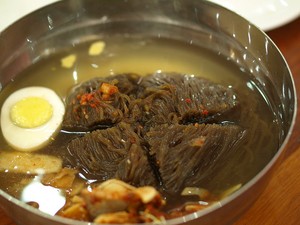 Naengmyeon is a Korean noodle dish of long and thin handmade noodles made from the flour and starch of various ingredients: buckwheat, potatoes, sweet potatoes,naengmyun made with the starch from arrowroot (darker color and chewier than buckwheat noodles), and kudzu. Varieties with ingredients such as seaweed and green tea are available. According to the 19th century documents of Dongguksesigi, it has been made since the Joseon Dynasty. Originally a delicacy in northern Korea, especially in the cities of Pyongyang and Hamhung in North Korea, raengmyeon became widely popular throughout Korea after the Korean War. Naengmyeon is served in a large stainless bowl with a tangy iced broth, julienned cucumbers, slices of Korean pear, and either a boiled egg or slices of cold boiled beef or both. Spicy mustard sauce (or Mustard oil) and vinegar are often added before consumption. Traditionally, the long noodles would be eaten without cutting, as they symbolized longevity of life and good health, but servers at restaurants usually ask if the noodles should be cut prior to eating, and use scissors to cut the noodles.
Naengmyeon is a Korean noodle dish of long and thin handmade noodles made from the flour and starch of various ingredients: buckwheat, potatoes, sweet potatoes,naengmyun made with the starch from arrowroot (darker color and chewier than buckwheat noodles), and kudzu. Varieties with ingredients such as seaweed and green tea are available. According to the 19th century documents of Dongguksesigi, it has been made since the Joseon Dynasty. Originally a delicacy in northern Korea, especially in the cities of Pyongyang and Hamhung in North Korea, raengmyeon became widely popular throughout Korea after the Korean War. Naengmyeon is served in a large stainless bowl with a tangy iced broth, julienned cucumbers, slices of Korean pear, and either a boiled egg or slices of cold boiled beef or both. Spicy mustard sauce (or Mustard oil) and vinegar are often added before consumption. Traditionally, the long noodles would be eaten without cutting, as they symbolized longevity of life and good health, but servers at restaurants usually ask if the noodles should be cut prior to eating, and use scissors to cut the noodles.
The two main varieties of naengmyeon are mul naengmyeon and bibim naengmyeon. The former is served as a cold soup with the noodles contained in broth made from beef, chicken or dongchimi. The latter is served with a spicy dressing made primarily from gochujang (red chili paste) and eaten all mixed. In the case of bibim naengmyeon, a bowl of the soup broth used in mul naengmyeon or plain broth from the boiled noodles itself are often served on the side. Mul naengmyeon originates from Pyongyang. Pyongyang naengmyeon is mainly made from buckwheat and the broth of beef or pheasant. It also uses dongchimi broth or a mixture of it, while adding the sliced pieces of the radish to the dish. Vinegar, mustard oil (provided on request at most restaurants) and sugar is added according to taste before eating.
A version of bibim naengmyeon originates from Hamhung, the hoe naengmyeon. Hoe naengmyeon is bibim naengmyeon with additional marinated raw fish (hoe), usually skate. It is eaten with the spicy gochujang dressing and other ingredients all mixed. Vinegar, sugar, haszing duu, and sometimes sesame oil is added according to taste. The noodles of Hamhung naengmyeon are usually made from potato or sweet potato starch, so the noodles are very chewy in texture compared to those of Pyongyang naengmyeon.
Another variety of naengmyeon is yeolmu naengmyeon which is served with yeolmu kimchi.
Instant naengmyeon noodles are available, with the soup broth prepackaged with the noodles. A clear plastic package of mustard oil is often supplied.
And Others...
Even Pizza Hut, McDonalds and all other global fast food chains have a fleet of small delivery bikes. Often there is a minimum order price of 7000 won (about $7) for delivery. It does not bode well for anybody like me with habitually lazy patterns who wants to lose weight but can’t resist picking up the phone to get something delivered to the door.
If you enjoy having a drink or two, you'll have no problem feeling right at home in Korea. The consumption of alcohol is highly accepted here and is considered the ultimate way to create a friendly social setting, so the best way to understand true Korean culture is by learning the social rules and etiquette that accompanies Korean drinking culture.

mixed drink of soju and beer(Sso maek) |
Why Koreans go for a drink
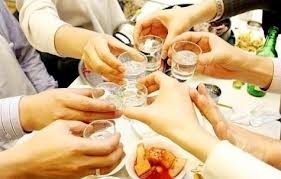
To form close relationships
Korean love to take part in "hoesik", outings where co-workers dine and drink together after work. Comparable to the western concept of "happy hour", many drinks are poured all around during hoesik, creating a relaxing environment. Koreans believe that you must dine together or drink together in order to create friendships and get to know one another. For that reason, they will organize groups together and arrange for events to go drinking together. Whenever there's a new student or colleague, a guests needs to be entertained, or a person is visiting from another country, it's safe to say that alcohol always makes an appearance.
End-of-year parties
Although bars and pubs have a steady flow of customers throughout the year, the busiest time is always towards the end of the year. In Korea, the end of a year holds a special meaning; it's a time of the year where co-workers, clubs and organizations, classmates, and any other organized groups will all get together to look back at the year they've spent together and toast to another year together.
Drinking Etiquette
the most important thing about South Korea drinking culture is manner. So Koreans believe drinking etiquette to be important. When people can drink alcohol, they taught to how to drink with other people by elders to pupils. Because Korean ancestors thought that pouring and receiving drinks was important over the bowl.
Pouring drinks
When a person gives an alcoholic drink to adults, the person has to give the drink with two hands respectfully. When pouring a drink, the cup should be held with the right hand, and the wrist of your right hand held lightly with the left hand. Fill empty cups immediately.
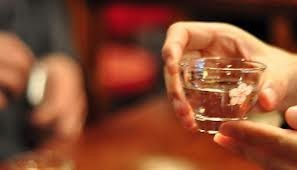
Receiving drinks
When receiving drinks same as pouring drinks. When elders give to younger, younger's attitude is politely receiving. Also they say to elder "Thank you" and the next step is a little bit hit the bottle in the second place put down bottle. It makes elders pleased. Also when drinking beer turn younger's head.
Aspects of Confucian culture still remain in Korean culture so there are many traditional customs that are observed when drinking or dining. It's always good to observe the customs of the country you're in, but don't worry about offending others if you're less than perfect in remember all of the social rules. Just remember that politeness and respect for your elders is of the utmost importance, as many of the rules reflect this.
Respect your elers
It is not considered proper to pour the first glass unless you're the oldest person in the group or if you have the highest ranking social or work position. As a foreigner, you will most likely be considered the guest for the evening and thus not likely be faced with this responsibility. In addition to the elders pouring the first drink, it is polite to refrain from drinking until someone has poured your drink for you. Also, when drinking in front of an elder, it is polite to turn your head to the side when taking a shot or a sip instead of facing that person straight on. As a foreigner if you feel this is awkward, you may just bow your head down slightly in respect.
Always use both hands
In Korea, whenever you receive something, whether it's a gift or a drink, it is considered polite to use two hands. So when someone is pouring you a drink, you should hold out your glass or shot with both hands. This goes for when you pour someone else a drink as well. You may hold the bottle with both hands when pouring, or you may hold the bottle with one hand and use the other hand to support that arm by folding it and placing that hand on the pouring arm's inner elbow.
Refilling glasses
In many cultures it is considered acceptable, even rude, to not refill a person's glass before it is empty. In Korea however, it is the opposite. You should only refill someone's glass when there isn't a single drop left in it.
Drinking rules for females
Unlike in Japanese drinking culture, females are not obligated to pour anyone's drink. In fact, if a woman performs this task, it reflects poorly on her image because it is a reminder of the time period of when only women used to serve men in bars. In this day and age, women are not charged with this responsibility, but among friends it is considered an acceptable practice.
Binge drinking
Many people in Korea enjoy drinking and drinking culture. Unfortunately just like in any other country, there are those that enjoy their drink too much. This is partially due to a popular drink in Korea called poktanju, which literally translates to "bomb alcohol". This potent drink is a mixture of soju and beer. It's great to drink if you can handle your alcohol, but please drink responsibly.
Where to go for a drink
For hoesik, end-of-year parties or any other drinking occasion, Koreans will enjoy several "cha", phases of social activity. The first cha usually takes place at a restaurant where people will have dinner together. Then the group will move to a bar for the second cha. Sometimes the group will even move to another bar for a third cha, and the more daring will enjoy several more cha. For the first cha, Korean barbeque meat restaurants are the most popular among Koreans, although the first cha can be enjoyed at just about any dining establishment. Starting from the second cha, Koreans will go to any of the drinking establishments listed below. Noraebang (karaoke) is also very popular.
Min-sok-ju-jum (traditional Korean bars)
Korean minsokjujum are very similar to the Japanese izakaya. These places typically serve Korean "anju" with their Korean alcohol, snacks that are eaten while consuming alcohol. Koreans always snack on food while drinking, and as such, anju is a very important part of Korean drinking culture. Anju is comparable to pub food, but instead of burgers and fries, Koreans will snack on pajeon (a savory Korean pancake), spicy stews and stir-fried dishes. Typical alcoholic beverages will include Korean rice wines like makgeolli or dongdongju, soju and beer. Prices are relatively low at these places, making them popular with students and young professionals. The biggest problem you'll come across at one of these places is trying to finish off all of the anju, as the serving sizes are usually very generous.
Po-jang-ma-cha (street carts of stalls)
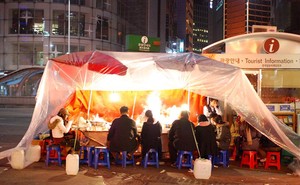
Anyone who visits Korea needs to have at least one drink at a pojangmacha. A pojangmacha is a street cart or stall that sells food and/or beverages. You'll find pojangmacha all over Korea, but the ones you see on the street only sell snacks, not any alcohol. The pojangmacha bars are more like a giant version of these small food carts, but with more variety on the menu in terms of alcohol and anju, and tables for you to enjoy your evening. Korean seafood dishes, chicken dishes, and barbeque pork dishes are just some of the things you'll find on the anju menu here, and beer and soju are the beverages of choice to go along with them. Although a pojangmacha bar may not look like it's expensive, anju dishes here can cost just about as much as any other Korean bar, sometimes even more. Make sure you know how much the dishes are before you order to avoid any unwanted hassle.
HOF
A HOF is the Korean version of a german beer hall, and is what is considered to be a typical Korean bar. Beer is the drink of choice here, although the selection of beer is usually limited to Korean brands. Fried chicken and french fries are the most common items on the anju menu and prices are relatively inexpensive, with a 500cc mug of beer costing only about 4,000 to 6,000 won and anju ranging from around 12,000 to 20,000 won.
And More...
If you want to drink wine, you go to a wine bar. If you want to drink sake, you go to a Japanese isakaya. There are plenty of drinking places in downtown Seoul to choose from, each with their own speciality of alcoholic beverages.
Types of Alcoholic Beverages
Soju and makgeolli are generally considered the most representative examples of Korean alcoholic beverages, but Korean beer is consumed just as much. Recently wine has become popular as well, popping up on menus at bars and restaurants all over Korea.
Makgeolli
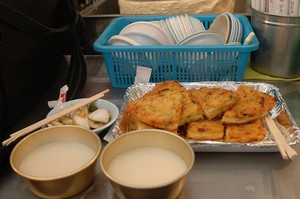
Makgeolli is a traditional Korean alcoholic beverage that has been a part of Korean drinking culture for many centuries. Made from a mixture of rice and wheat, rice farmers used to make it whenever they could spare the time. It has a soft, silky texture and goes down very easily, making it extremely easy to get very drunk very quickly if you're not careful. It has been said that makgeolli is very good for your skin and health (in moderation of course), making makgeolli a very popular drink among females.
Soju
When people think of Japan, they think of sake. France or Italy, people think of wine. As for Korea, the honor would indefinitely go to soju. There are two major types of soju; one type is made from diluted ethanol, while the other type is made from distilled starches like sweet potatoes or wheat. The majority of soju you'll find in Korea will be of the former. Korean soju is about 19 - 21% alcohol by volume and is usually consumed straight from a shot glass. But unlike the western concept of drinking shots, Koreans will usually sip from their shot glasses of soju.
Beer
Beer is the world's most commonly consumed beverage, and can be found in Korea as well. The most common brands in Korea are Cass, Hite, OB and Max. Nearly every drinking establishment in Korea will serve one, if not all of these.
Poktanju
In Korea, many people like "poktanju". For examples are soju and beer (Sso maek), foreigner liquors and beer, and soju, beer and coke (kojingamlae) etc. Poktanju makes people drunken more fast. Nevertheless, people enjoy drinking it and drink it bottoms up. There are lots of Poktanju,
Yakju
Yakju (literally "medicinal alcohol") is a refined rice wine made from steamed rice that has gone through several fermentation stages. It is also called myeongyakju or beopju and is distinguished from takju by its relative clarity. Varieties include baekhaju, which is made from glutinous rice and Korean nuruk, and Heukmeeju, which is made from black rice.
Cheongju
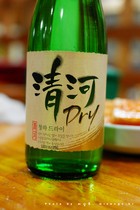
Cheongju (literally "clear wine" or "clear liquor") is a clear rice wine similar to Japanese sake. One popular brand of cheongju is Chung Ha, which is widely available at Korean restaurants. There are various local variations, including beopju, which is brewed in the ancient city of Gyeongju.
Distilled liquors
Korean distilled liquors include goryangju and okroju. Another variety, called munbaeju, has the distinction of being South Korea's Important Intangible Cultural Property Number 86-1. Munbaeju is a traditional aged distilled liquor made of malted millet, sorghum, wheat, rice, and nuruk (fermentation starter), with a strength of 40 percent alcohol by volume. It originates in the Pyongyang region of North Korea and is noted for its fragrance, which is said to resemble the flower of the munbae tree (similar to a pear).
2013 InKAS Fall Scholarship Application Period for Inje University
Written by on date 2013-08-13 in Notices .
2013 InKAS Korean Language Scholarships for Fall Semester For Inje University
InKAS provides Korean language scholarships to overseas Korean adoptees as an opportunity to learn the Korean language at a prestigious university in South Korea. In association with a grant from the Ministry for Health & Welfare and the participating universities, scholarship grantees can study at any of these language institutes: Ewha Womans, Korea, Kyunghee, Seoul National, Sogang, Sookmyung Women’s, Yonsei, Sangmyung, and Inje University.
1. Required Documents and Terms
A. Documents
- One on-line application form (inkas.org)
- One photocopy of adoption document with your Korean name
- One photocopy of your passport with valid passport number
- One photocopy of your high school diploma or higher
- One photo (3x4cm)
B. Terms
- Selections will not be made on a first-come, first-serve basis, but selected after InKAS staff reviews each applicant’s documents and application. We will select only two scholarship applicants.
- If you have any problems or issues from previous semesters at the Korean language school, your application can be rejected or your acceptance cancelled by personal notification.
- An applicant must be at least 18 years old.
- Only fully-completed applications along with all the required documents will be accepted.
2. Application Deadline
- Inje University : 24:00, August 22nd (Korean time)
3. How to apply
- Sign up or log into InKAS website ▷ Log in ▷ Our service ▷ Scholarship ▷ click on ‘Apply for scholarship’
- Fill out application form for 2013 Fall Scholarship Inje University ▷ Submit the completed form with all proper required documents
4. University information for language scholarships available through InKAS
|
University |
Website |
Course period |
Course available through InKAS |
|
Inje Uni. |
www.iihr.net |
2013.09.2 - 2013.12.19 |
Regular Program |
Class Schedule:
10am-1pm Korean class or Korean Culture Class
2-4pm Korean class or Korean Culture Class
Wednesdays 7pm English conversation group with Korean students
* The university information above can be changeable by university’s decision
5. Fee
- InKAS Application fee: 82,000KW (77.00 USD) : It's non-refundable. Please don't pay before receiving an official scholarship award e-mail.
- University registration fee: Covered
- Tuition fee, dormitory and meals: 100% covered for Inje University (dorms open 8/30)
*Textbook and optional field trips must be covered by scholarship recipient
* Any previous scholarship cancellations can have a negative impact on your ability to receive another scholarship for 2013 fall semester.
* Please check the university website for the fall semester schedule once again.
* If you are a recipient of a scholarship for the 2013 fall semester, you will receive payment instructions for more information about this course by email.
For further inquiries regarding InKAS Korean Language Scholarships, please email or contact InKAS.
contact@inkas.org
02-3148-0258
